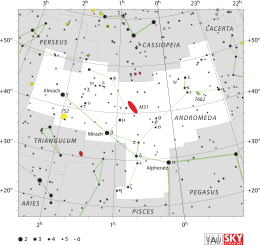|
NGC 708 è una galassia ellittica distante 240 milioni di anni luce[2] nella costellazione di Andromeda e fu scoperta dall'astronomo William Herschel il 21 settembre 1786.[3] Viene classificata come una galassia cD[4][5] ed è la galassia più luminosa di Abell 262.[6][7] NGC 708 è una debole[8] radiogalassia FR I[9][10][11][12][13] ed è anche classificata come una galassia di Seyfert di tipo 2.[14]
NGC 708 è circondata da 4700 ammassi globulari.[15]
Buco nero supermassiccio
NGC 708 ha un buco nero supermassiccio con una massa stimata di (2,9×108 M☉) (108.46) M☉.[10][16]
Il buco nero supermassiccio sta alimentando i getti radio e i lobi nella galassia.[10]
Morfologia radio
NGC 708 contiene due getti radio[17] che sono leggermente piegati[18] e si estendono in lobi radio doppi[10][11][13] a forma di "s"[8][12] con una lunghezza totale di 60 kpc (200 000 al).
Osservazioni del Chandra hanno mostrato che i lobi hanno creato una cavità nel mezzo intraammasso (ICM, da intercluster medium) di Abell 262.[11]
Possibile interazione
NGC 708 potrebbe stare interagendo con NGC 705 che si trova a circa 20,6 kpc (67 000 al) a sud-ovest.[19]
Gruppo di NGC 669
NGC 708 fa parte del Gruppo di NGC 669.[20] Questo gruppo contiene più di una trentina di galassie, 15 delle quali compaiono nel New General Catalogue e 3 nell'Index Catalogue.
Note
- ^ a b c d e NASA/IPAC Extragalactic Database, in Results for NGC 708. URL consultato il 22 dicembre 2018.
- ^ Your NED Search Results, su ned.ipac.caltech.edu. URL consultato il 23 dicembre 2018.
- ^ (EN) New General Catalog Objects: NGC 700 – 749, su cseligman.com. URL consultato il 21 novembre 2018.
- ^ N. Lyskova, E. Churazov e A. Moiseev, Stellar kinematics of X-ray bright massive elliptical galaxies, in Monthly Notices of the Royal Astronomical Society, vol. 441, n. 3, 15 maggio 2014, pp. 2013-2033, Bibcode:2014MNRAS.441.2013L, DOI:10.1093/mnras/stu717, ISSN 0035-8711 (WC · ACNP), arXiv:1404.2729.
- ^ Charles F. Goullaud, Joseph B. Jensen e John P. Blakeslee, The MASSIVE Survey. IX. Photometric Analysis of 35 High-mass Early-type Galaxies with HST WFC3/IR, in The Astrophysical Journal, vol. 856, n. 1, 20 marzo 2018, p. 11, Bibcode:2018ApJ...856...11G, DOI:10.3847/1538-4357/aab1f3, ISSN 1538-4357 (WC · ACNP), arXiv:1801.08245.
- ^ M. J. West, Anisotropic Mergers at High Redshifts - the Formation of CD Galaxies and Powerful Radio Sources, in Monthly Notices of the Royal Astronomical Society, vol. 268, 1º maggio 1994, pp. 79-102, Bibcode:1994MNRAS.268...79W, DOI:10.1093/mnras/268.1.79, ISSN 0035-8711 (WC · ACNP).
- ^ NGC 708, su SIMBAD Astronomical Database. URL consultato il 23 dicembre 2018.
- ^ a b F. Durret, Nuclear and extranuclear ionized gas in nine Seyfert 2 galaxies, in Astronomy and Astrophysics Supplement Series, vol. 105, 1º maggio 1994, pp. 57-66, Bibcode:1994A&AS..105...57D, ISSN 0365-0138 (WC · ACNP).
- ^ (EN) P. Parma, R. Morganti e R. Fanti, The HST survey of the B2 sample of radio-galaxies: optical nuclei and the FRI/BL Lac unified scheme, in Astronomy & Astrophysics, vol. 383, 6 dicembre 2001, pp. 104-111, Bibcode:2002A&A...383..104C, DOI:10.1051/0004-6361:20011714, arXiv:astro-ph/0112151.
- ^ a b c d (EN) C. Hu e J.-M. Wang, Captures of Red Giant Stars by Black Holes in Elliptical Galaxies: Feedback to the Hot Gas, in The Astrophysical Journal, vol. 630, n. 2, 1º agosto 2005, pp. L125–L128, Bibcode:2005ApJ...630L.125W, DOI:10.1086/491670, arXiv:astro-ph/0508021.
- ^ a b c (EN) T. E. Clarke, Brian R. McNamara e Craig L. Sarazin, Chandra Observation of the Central Region of the Cooling Flow Cluster Abell 262: A Radio Source that is a Shadow of its Former Self?, in The Astrophysical Journal, vol. 612, n. 2, 21 maggio 2004, pp. 817-824, Bibcode:2004ApJ...612..817B, DOI:10.1086/422677, arXiv:astro-ph/0405425.
- ^ a b (EN) N. E. Kassim, E. M. Douglass e Gopal-Krishna, Tracing Multiple Generations of AGN Feedback in the Core of Abell 262, in The Astrophysical Journal, vol. 697, n. 2, 4 marzo 2009, pp. 1481-1492, Bibcode:2009ApJ...697.1481C, DOI:10.1088/0004-637X/697/2/1481, arXiv:0903.0844.
- ^ a b (EN) G. B. Taylor, M. Giroletti e G. Giovannini, Parsec-scale properties of brightest cluster galaxies, in Astronomy & Astrophysics, vol. 516, 1º giugno 2010, pp. A1, Bibcode:2010A&A...516A...1L, DOI:10.1051/0004-6361/200913888, ISSN 1432-0746 (WC · ACNP), arXiv:1002.1380.
- ^ Naveen A. Reddy e Min S. Yun, Radio and Far-Infrared Emission as Tracers of Star Formation and AGN in Nearby Cluster Galaxies, in The Astrophysical Journal, vol. 600, n. 2, 10 gennaio 2004, pp. 695-715, Bibcode:2004ApJ...600..695R, DOI:10.1086/379871, ISSN 0004-637X (WC · ACNP), arXiv:astro-ph/0309649.
- ^ William E. Harris, Gretchen L. H. Harris e Matthew Alessi, A Catalog of Globular Cluster Systems: What Determines the Size of a Galaxy's Globular Cluster Population?, in The Astrophysical Journal, vol. 772, n. 2, 9 luglio 2013, p. 82, Bibcode:2013ApJ...772...82H, DOI:10.1088/0004-637X/772/2/82, ISSN 0004-637X (WC · ACNP), arXiv:1306.2247.
- ^ (EN) Jong-Hak Woo e C. Megan Urry, Active Galactic Nucleus Black Hole Masses and Bolometric Luminosities, in The Astrophysical Journal, vol. 579, n. 2, 2002, pp. 530-544, Bibcode:2002ApJ...579..530W, DOI:10.1086/342878, ISSN 0004-637X (WC · ACNP), arXiv:astro-ph/0207249.
- ^ P. J. McCarthy, W. J. M. van Bruegel e T. Heckman, Optical and Radio Observations of the Cooling-Flow Galaxy NGC 708, in Bulletin of the American Astronomical Society, vol. 17, 1º settembre 1985, p. 865, Bibcode:1985BAAS...17..865M.
- ^ Yoshiaki Sofue e Ken-Ichi Wakamatsu, CO in elliptical galaxies and the universal CO-to-dust ratio, in Publications of the Astronomical Society of Japan, vol. 45, 4–6264, agosto 1993, pp. 529-538, Bibcode:1993PASJ...45..529S.
- ^ (EN) L. Colina e I. Perez-Fournon, Optical observations of galaxies containing radio jets – A catalog of sources with redshift smaller than 0.15, in The Astrophysical Journal Supplement Series, vol. 72, gennaio 1990, pp. 41-59, Bibcode:1990ApJS...72...41C, DOI:10.1086/191408, ISSN 0067-0049 (WC · ACNP).
- ^ A.M. Garcia, General study of group membership. II - Determination of nearby groups, in Astronomy and Astrophysics Supplement Series, 100 #1, luglio 1993, pp. 47-90, Bibcode:1993A&AS..100...47G.
Voci correlate
Altri progetti
|

